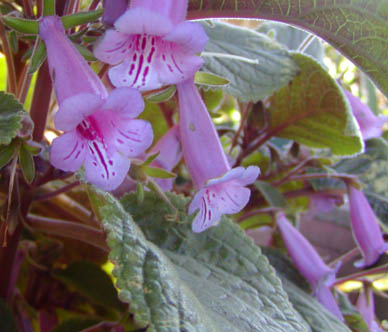Sinningia 'Peninsula Belle'
Sinningia 'Peninsula Belle' (S. lineata x reitzii) bears light purple flowers over a long blooming season. Like its reitzii parent, it can get to be a small shrub.

Sinningia 'Peninsula Belle' is one of my first hybrids. I made it back in the early 1980s, not long after I started growing sinningias. It is S. lineata x reitzii. I got the reitzii (then known as Sinningia "New Zealand") from the late Addison Campbell. The lineata I grew from AGGS Seed Fund seed (the seed was under the name S. macropoda). So from two misnamed plants I got a plant I have grown ever since, and eventually named and registered (my first).
Sinningia lineata has orange-red flowers with narrow tubes and slightly flaring lobes. Sinningia reitzii has dark red flowers with narrow tubes and slightly flaring lobes. So Sinningia 'Peninsula Belle' has magenta flowers with a wider tube and lobes flaring widely to create an almost flat face. Hybridizing is so predictable.